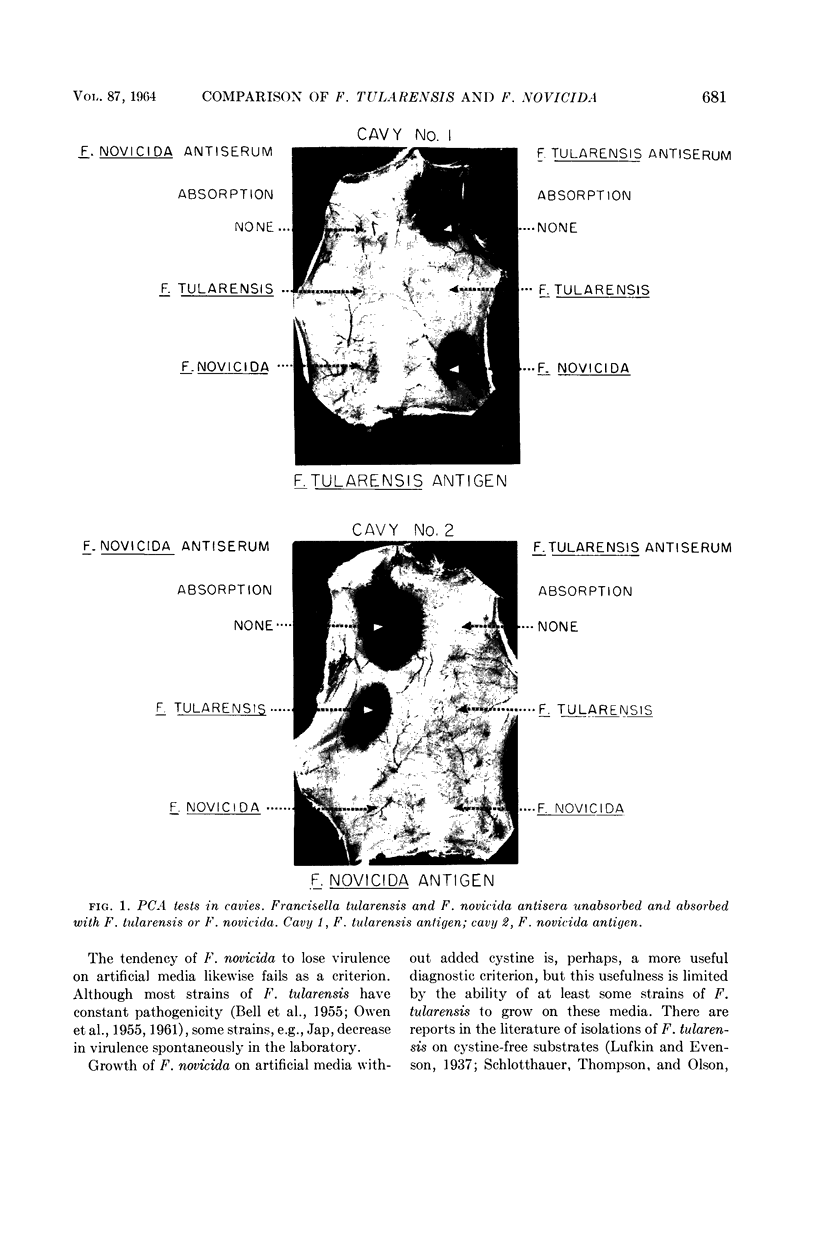Abstract
Owen, C. R. (U.S. Public Health Service, Rocky Mountain Laboratory, Hamilton, Mont.), E. O. Buker, W. L. Jellison, D. B. Lackman, and J. F. Bell. Comparative studies of Francisella tularensis and Francisella novicida. J. Bacteriol. 87:676–683. 1964.—Comparative studies of various properties of Francisella tularensis (= Pasteurella tularensis) and F. novicida were performed. The two organisms are very similar morphologically. Growth of both was markedly enhanced by addition of cystine to media, but F. novicida is less fastidious than F. tularensis. The virulence of F. novicida for mice and cavies is lower than that of fresh isolates of F. tularensis. In complement-fixation tests, some cross-reaction occurred when rabbit antisera were used; complement-fixation tests with cavy antisera were specific. Agglutination tests with sera from both rabbits and cavies were specific. Nonliving vaccines of the two organisms (extracts, whole dead cells) conferred no cross-protection to mice; living attenuated vaccines conferred cross-protection which was more transitory than was specific protection. Passive cutaneous anaphylaxis (PCA) tests were highly specific. Absorption of antisera with homologous organisms removed all PCA reactivity, while absorption with heterologous organisms left it almost intact. Hemagglutination and hemagglutination-inhibition tests were specific. It was concluded that the two organisms are sufficiently similar to belong in the same genus but sufficiently different to be retained in separate species.
Full text
PDF







Images in this article
Selected References
These references are in PubMed. This may not be the complete list of references from this article.
- ALEXANDER M. M., WRIGHT G. G., BALDWIN A. C. Observations on the agglutination of polysaccharide-treated erythrocytes by tularemia antisera. J Exp Med. 1950 Jun 1;91(6):561–566. doi: 10.1084/jem.91.6.561. [DOI] [PMC free article] [PubMed] [Google Scholar]
- BELL J. F., LARSON C. L., WICHT W. C., RITTER S. A. Studies on the immunization of white mice against infections with Bacterium tularense. J Immunol. 1952 Nov;69(5):515–524. [PubMed] [Google Scholar]
- BELL J. F., OWEN C. R., LARSON C. L. Virulence of Bacterium tularense. I. A study of the virulence of Bacterium tularense in mice, guinea pigs, and rabbits. J Infect Dis. 1955 Sep-Oct;97(2):162–166. doi: 10.1093/infdis/97.2.162. [DOI] [PubMed] [Google Scholar]
- HENDERSON D. W. Bacterial interference. Bacteriol Rev. 1960 Mar;24(1):167–176. doi: 10.1128/br.24.1.167-176.1960. [DOI] [PMC free article] [PubMed] [Google Scholar]
- LARSON C. L. Studies on thermostable antigens extracted from Bacterium tularense and from tissues of animals dead of tularemia. J Immunol. 1951 Feb;66(2):249–259. [PubMed] [Google Scholar]
- LARSON C. L., WICHT W., JELLISON W. L. A new organism resembling P. tularensis isolated from water. Public Health Rep. 1955 Mar;70(3):253–258. [PMC free article] [PubMed] [Google Scholar]
- OLSUFIEV N. G., EMELYANOVA O. S., DUNAYEVA T. N. Comparative study of strains of B. tularense in the old and new world and their taxonomy. J Hyg Epidemiol Microbiol Immunol. 1959;3:138–149. [PubMed] [Google Scholar]
- ORMSBEE R. A., LARSON C. L. Studies on Bacterium tularense antigens. II. Chemical and physical characteristics of protective antigen preparations. J Immunol. 1955 May;74(5):359–370. [PubMed] [Google Scholar]
- OVARY Z. [Quantitative studies in passive cutaneous anaphylaxis of the guinea pig]. Int Arch Allergy Appl Immunol. 1952;3(2):162–174. doi: 10.1159/000227958. [DOI] [PubMed] [Google Scholar]
- OWEN C. R., BELL J. F., JELLISON W. L., BUKER E. O., MOORE G. J. Lack of demonstrable enhancement of virulence of Francisella tularensis during animal passage. Zoonoses Res. 1961 Dec 20;1:75–85. [PubMed] [Google Scholar]
- OWEN C. R., BELL J. F., LARSON C. L., ORMSBEE R. A. Virulence of Bacterium tularense. II. Evaluation of criteria of virulence of Bacterium tularense. J Infect Dis. 1955 Sep-Oct;97(2):167–176. doi: 10.1093/infdis/97.2.167. [DOI] [PubMed] [Google Scholar]
- SASLAW S., CARLISLE H. N. Studies with tularemia vaccines in volunteers. IV. Brucella aggiutinins in vaccinated and nonvaccinated volunteers challenged with Pasteurella tularensis. Am J Med Sci. 1961 Aug;242:166–172. doi: 10.1097/00000441-196108000-00004. [DOI] [PubMed] [Google Scholar]



